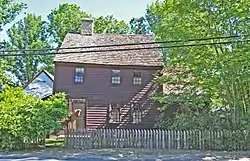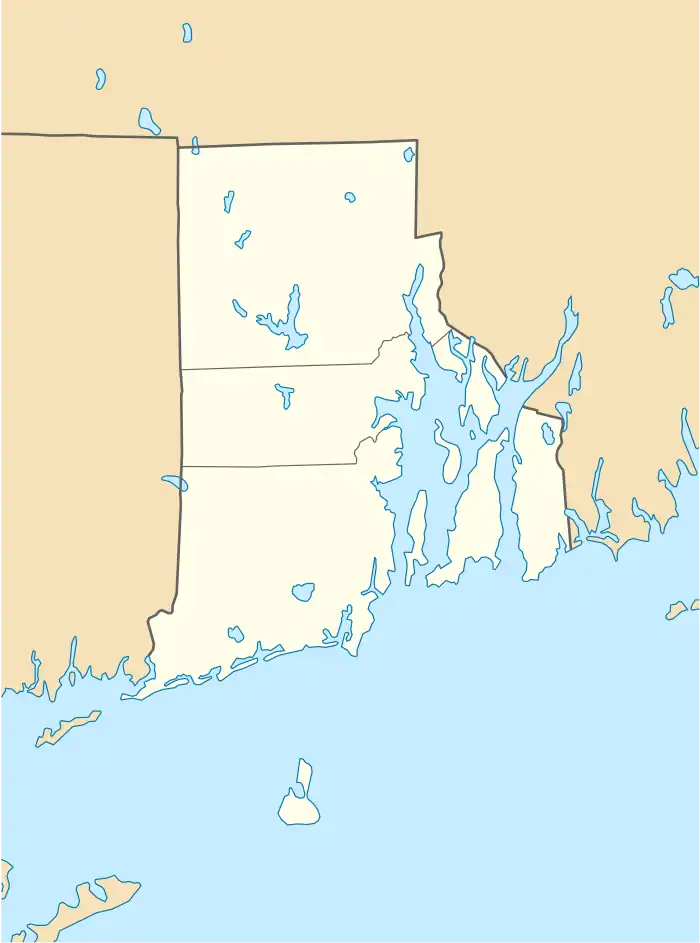Bradford, Rhode Island
Bradford is a census-designated place (CDP) and historic district in the towns of Westerly and Hopkinton in Washington County, Rhode Island, United States. The population was 1,406 at the 2010 census. The Bradford Village Historic District was listed on the National Register of Historic Places in 1996 as a 224-acre (91 ha) area including 149 contributing buildings, one other contributing site, and one other contributing structure. The CDP as defined by the United States Census Bureau is located only in Westerly.
Bradford, Rhode Island | |
|---|---|
 Solomon P. Wells House in the historic district | |
 Bradford, Rhode Island Location in the state of Rhode Island | |
| Coordinates: 41°24′2″N 71°44′51″W | |
| Country | United States |
| State | Rhode Island |
| County | Washington |
| Area | |
| • Total | 1.83 sq mi (4.75 km2) |
| • Land | 1.82 sq mi (4.71 km2) |
| • Water | 0.01 sq mi (0.04 km2) |
| Elevation | 39 ft (12 m) |
| Population | |
| • Total | 1,457 |
| • Density | 801.87/sq mi (309.55/km2) |
| Time zone | UTC-5 (Eastern (EST)) |
| • Summer (DST) | UTC-4 (EDT) |
| ZIP code | 02808 |
| Area code | 401 |
| FIPS code | 44-08020[3] |
| GNIS feature ID | 1217668[4] |
Bradford Village Historic District | |
  | |
| Location | Westerly and Hopkinton |
|---|---|
| Built | 1732 |
| Architect | Sherman, R.A., Sons & Co. |
| Architectural style | Bungalow/Craftsman, Tudor Revival, Greek Revival |
| NRHP reference No. | 96000573 [5] |
| Added to NRHP | May 30, 1996 |
Bradford was named for Bradford, West Yorkshire, England.
Geography
Bradford is located at 41°24′2″N 71°44′51″W (41.400657, -71.747607).[6]
According to the United States Census Bureau, the village has a total area of 4.9 km2 (1.9 mi2), all land.
Demographics
| Census | Pop. | Note | %± |
|---|---|---|---|
| 2020 | 1,457 | — | |
| U.S. Decennial Census[7] | |||
As of the census[3] of 2000, there were 1,497 people, 482 households, and 397 families residing in the village. The population density was 795.0/mi2 (307.4/km2). There were 496 housing units at an average density of 263.4/mi2 (101.9/km2). The racial makeup of the village was 96.33% White, 0.67% African American, 0.73% American Indian, 0.60% Asian, 0.40% from other races, and 1.27% from two or more races. Hispanic or Latino were 1.94% of the population.
There were 482 households, out of which 51.0% had children under the age of 18 living with them, 59.5% were married couples living together, 16.6% had a female householder with no husband present, and 17.6% were non-families. 13.5% of all households were made up of individuals, and 4.4% had someone living alone who was 65 years of age or older. The average household size was 3.10 and the average family size was 3.39.
In the village, the population was spread out, with 35.7% under the age of 18, 7.1% from 18 to 24, 34.1% from 25 to 44, 15.9% from 45 to 64, and 7.2% who were 65 years of age or older. The median age was 30 years. For every 100 females, there were 103.4 males. For every 100 females age 18 and over, there were 97.3 males.
The median income for a household in the village was $42,130, and the median income for a family was $40,370. Males had a median income of $36,250 versus $24,353 for females. The per capita income for the village was $14,004. About 12.4% of families and 13.1% of the population were below the poverty line, including 17.4% of those under age 18 and none of those age 65 or over.
Environmental contamination
Bradford is a working-class village in southwest Rhode Island where the Bradford Dyeing Association (BDA) has operated for nearly 100 years. BDA is the largest producer of battle dress uniform fabrics to the U.S. Dept. of Defense.[8]
In violation of the federal Clean Air and Clean Water Acts, the BDA plant polluted the Pawcatuck River and fouled the local air. The RI DEM (Department of Environmental Management) was not responding to local complaints about the contamination so the Bradford Coalition 2 Stop Pollution, a community group of homeowners and tenants, lobbied to reduce BDA's pollution.[9]
A civil lawsuit was successfully filed in 2005 in collaboration with the TAC (Toxic Action Center),[10] RIPIRG (Rhode Island Public Interest Research Group) and Sierra Club. The BDA settled in November 2005, agreeing to pay $150,000 in fines and make improvements on the textile mill to reduce pollution. The plant will build taller smokestacks, install a soot-reducing device and better manage its sewage sludge pond.[11]
“State and federal environmental regulators had given BDA a free pass for years,” explained RIPIRG Advocate Matthew Auten. “By requiring the company to significantly upgrade its air pollution and water pollution controls, this settlement demonstrates the important role that citizens can and often must play in enforcing our environmental laws.”[12]
In 2011, BDA's success was already in decline [13] and as of 2019, the association was shut down and site sold.[14]
References
- "ArcGIS REST Services Directory". United States Census Bureau. Retrieved October 12, 2022.
- "Census Population API". United States Census Bureau. Retrieved October 12, 2022.
- "U.S. Census website". United States Census Bureau. Retrieved January 31, 2008.
- "US Board on Geographic Names". United States Geological Survey. October 25, 2007. Retrieved January 31, 2008.
- "National Register Information System". National Register of Historic Places. National Park Service. January 23, 2007.
- "US Gazetteer files: 2010, 2000, and 1990". United States Census Bureau. February 12, 2011. Retrieved April 23, 2011.
- "Census of Population and Housing". Census.gov. Retrieved June 4, 2016.
- Bradford Dyeing Association – About our company Archived 2008-01-06 at the Wayback Machine
- http://www.geocities.com/altoncommunityaction/sun827.doc
- Bradford Dyeing Association Inc. Pollution Fines
- "Toxicaction.org". Archived from the original on September 21, 2017. Retrieved December 31, 2018.
- National Environmental Law Center Archived 2007-07-10 at the Wayback Machine
- "Bradford Dyeing is dying".
- "Bradford mill property reported sold for $325,000".
